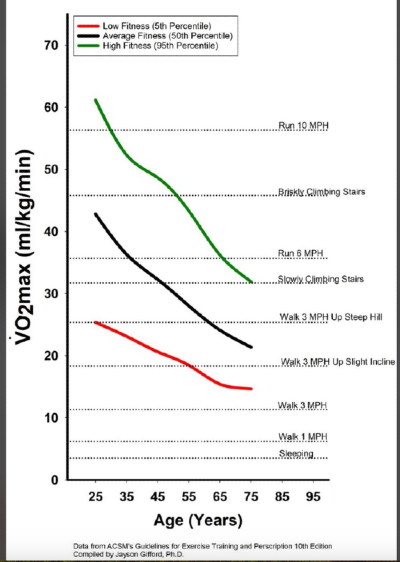Exercise for Longevity Part 2
What is your "why"? What do you want to be doing physically now and into your old age? Peter Attia, author of Outlive says the answer to this question should direct your exercise routine. Let's discuss the three other exercises he recommends that weren't covered in Part 1.

Welcome back for Part 2 in our discussion on using exercise as insurance towards living a long and healthy life. as described in Peter Attia's Outlive: The Science and Art of Longevity.
In last week's post, I explained why exercise is so important and introduced Zone 2 training. Here I'll discuss the second type of cardio that Peter mentions in his book as well as the other two tenets of exercise he endorses.
Maximum Aerobic Output: VO2 Max
"It turns out that peak aerobic cardiorespiratory fitness, measured in terms of VO2 max, is perhaps the single most powerful marker for longevity."
If VO2 is the rate at which you can consume and utilize oxygen, VO2 max. is your maximum oxygen consumption rate aka your peak aerobic capacity. The more oxygen you can use, the more energy you can produce.
Although Peter doesn't discuss exactly how training to improve your VO2 max helps you on a biological level (like he does with Zone 2), he does stress that increasing your VO2 max "makes you functionally younger" and almost every activity is quantified using this value i.e a hike in the mountains requires a VO2 max of about 30 ml/kg/min. See the graph below.

Peter emphasizes that VO2 max decreases as you age, roughly 10-15% every decade. So if you want to ensure you're hiking mountains when you're 80, your VO2 max should be 50 ml/kg/min or higher when you're 35. Knowing your VO2 max requires a special test where you exercise while wearing a mask. I've never had this done, but Apple Fitness estimates that mine is 51 🤷🏻♀️
What: Cardio at a high level of intensity, but not an all-out sprint.
How: 4 mins ON x 4 mins OFF x 4-6. Four minutes at the maximum pace you can sustain, followed by four minutes of easy pace, allowing your heart rate (HR) to drop below 100 BPM. Repeat this 4 to 6 times and then cool down.
How I've implemented this: This is a completely new type of workout for me and is probably the hardest to implement. While Peter uses a stationary bike or rowing machine (which I'm a little jealous of), I've been sprinting on a paved trail or running a long hill close to my house. It. is. hard. My HR oscillates between Zone 2, 3, and 4 during the four minutes "On", although the majority is spent in Zone 3, as you can see from the HR graphs below comparing my recent VO2 max training with my Zone 2 training. (Finding your VO2 max requires a


My HR from VO2 max workout (on left) vs Zone 2 workout (taken from Apple Fitness app)
Strength
I used to strength train religiously 3-4 times a week but didn't love how bulky I felt. So I abandoned lifting weights altogether in favor of cardio and HIIT workouts and was happy with the results. However, the argument that muscles (and bone density) protect us from injury, like armor, is pretty sound.
It was also a bit shocking to find out just how just how difficult it is to build muscle as we age, and that "muscle mass begins to decline as early as our thirties." The adage "If you don't use it, you lose it." applies in a significant way to muscle mass, strength, and power as well:
"Even if someone has been training diligently, a short period of inactivity can erase many of those gains."
Daily life and zone 2 training, may be enough to prevent atrophy of Type 1 fibers, however, unless you are "working against significant resistance," it's not enough to preserve your fast twitch or Type 2 muscle fibers.
What: The book is much less prescriptive regarding strength training, which is honestly not surprising given there are 100+ page books on this topic alone. However, Peter does mention that he structures his training around exercises that improve the following:
- grip strength,
- concentric and eccentric loading,
- pulling motions, and
- hip-hinging movements.
He also mentions that he likes to "ruck" around his neighborhood for 1 hour 3-4 times a week with a 50-60 lb pack on his back. (This neighborhood walk is 3-4 miles with several hundred feet of elevation change.) At this point, you might be thinking "How does this man have the time (and stamina) to exercise this much!?" 🤷🏻♀️ I have the same question . . .
How I've implemented this: I've (pseudo-reluctantly) incorporated strength training back into my afternoon workouts via the 30-minute Apple Fitness+ strength workouts. Although they're a little repetitive and I'm not sure they're my long-term solution, they have helped get me back into lifting (baby) weights.
Stability
While Zone 2, VO2 max, and strength training were all covered in one chapter, Peter dedicates an entirely separate chapter to Stability. Why?
"All the aerobic fitness or strength in the world won't help you if you get hurt and have to stop exercising for several months - or forever."
And Peter believes stability is key to preventing injury. He explains that most "acute" injuries likely stem from a chronic weakness or lack of stability at the foundation of the joint. Stability training, he says, is retaining our bodies and our minds to move in the (perfect) way we learned as little kids. This is the focal point of dynamic neuromuscular stabilization or DNS where numerous videos appear online. He also has some free videos of stability training on his website. Peter spends 1 hour doing dedicated stability training twice a week, with 10-15 minutes on the other days.
How I've implemented this: I'm not going to lie, I haven't dedicated as much time to stability exercises, mainly because it's not straightforward yet how I personally need to approach this. However, I try to do some kind of yoga at least 1-2 times per week and have made a note (for myself) to research the DNS exercises further.
The following is how I've tried to implement all of the suggestions covered in Part 1 and Part 2 thus far. On most days, I'm working out twice a day.
- Monday: 45 min run, upper body strength
- Tuesday: VO2 max workout, lower body strength
- Wednesday: 45 min run
- Thursday: 45 min run, total body strength
- Friday: walk, yoga
- Saturday: 60+ min run
- Sunday: Rest
Find Your Why
I've been asked several times this year if I'm training for a race (a symptom of living in an outdoor-centric town surrounded by healthy people!) To which I reply "No, I'm training for life!" I don't actually say that because it would make me sound ridiculous. However, this question does make me think about what I'm training for - what is my "why?" For starters, I'm reluctant to register for a running race because it will most likely cause me to focus on cardio over strength, like I have in the past, and trade long runs for social time with friends (which I've also done in the past.) I'm also trying to take a page out of Atomic Habits and fall in love with the process of exercising rather than focusing on a particular goal/race.
I do know that I like to stay "trail-ready" i.e. be able to complete any trail that's <20 miles in a day, if need be. Hopefully, this means I can hike 5 miles when I'm 80 👵🏻 Additionally, I like how exercise makes me feel and look.
What is your "why"? What do you want to be doing now and into your old age?
,
